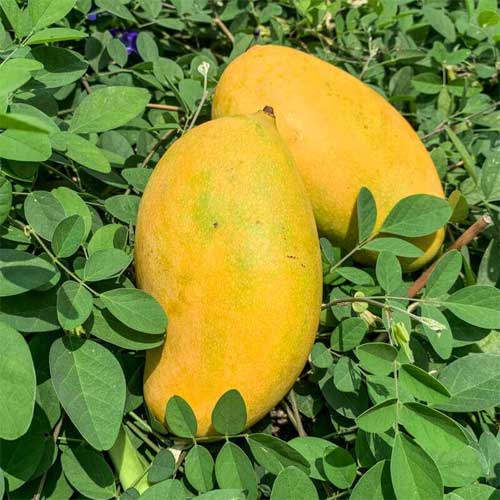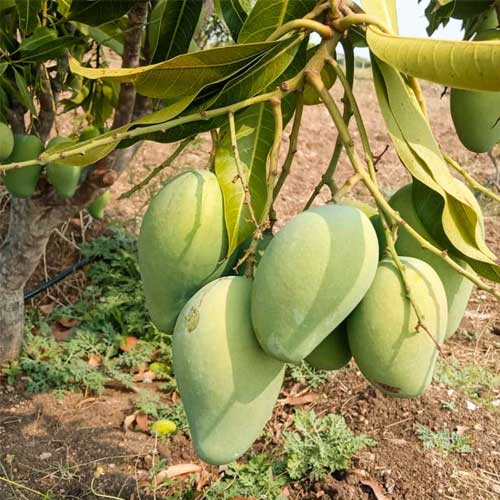Mallika Mango Grafted Live Plant
Introduction
The Mallika Mango Grafted Live Plant is a premium mango variety known for its delicious, sweet fruits and high productivity. 🌳 This grafted plant from Golden Hills Farm offers superior fruit quality, early fruiting, and resistance to common mango diseases. Perfect for home gardens, balconies, or commercial orchards, the Mallika Mango Plant delivers mangoes weighing 300–500 grams, ideal for fresh eating, juicing, and culinary uses. With proper care, this plant guarantees bountiful harvests year after year.Mallika Mango Grafted Live Plant
About This Item
- Variety: Mallika Mango
- Fruit Weight: 300–500 grams per fruit
- Special Features: Grafted for superior quality, high yield, and disease resistance
- Ideal For: Home gardens, balconies, and commercial orchards
- Sunlight Requirements: 6–8 hours of direct sunlight daily
- Soil Type: Well-draining, nutrient-rich soil
- Fertilizer Needs: Organic compost or manure every 2–3 weeks
- Life Span: Perennial
- Maintenance Level: Low to Moderate
What Size Grow Bag is Best?


Specifications and Details
| Specification |
Details |
| Variety |
Mallika Mango |
| Fruit Weight |
300–500 grams per fruit |
| Special Features |
Superior fruit quality, high yield, and disease resistance |
| Ideal For |
Home gardens, balconies, commercial orchards |
Growing Season in India
The Mallika Mango thrives in India’s tropical and subtropical climates, making it suitable for year-round planting. Spring is the best season for planting to ensure robust growth and early fruiting. With consistent care, the plant adapts well to various regions across India.
How to Grow in Pots
- Choose the Right Pot: Select a pot with a minimum size of 15 inches and good drainage.
- Prepare the Soil: Use nutrient-rich, well-draining soil mixed with compost.
- Planting: Place the plant carefully, covering the roots with soil.
- Watering: Water immediately after planting and maintain moist soil.
- Placement: Place in a sunny spot for 6–8 hours of sunlight daily.
Plant Care Tips
- Sunlight: Requires full sun exposure for 6–8 hours daily.
- Soil: Thrives in well-draining, organic-rich soil.
- Watering: Keep the soil consistently moist, avoiding waterlogging.
- Fertilization: Apply organic compost every 2–3 weeks to boost growth.
- Pruning: Remove dead or damaged branches to maintain healthy growth.
- Pest Control: Inspect regularly for pests and use neem oil or organic solutions.
- Mulching: Use mulch to retain soil moisture and prevent weed growth.
How to Fertilize Plants Effectively
1. Apply Nutrient-Rich Fertilizers
When your plants begin flowering, use nutrient-rich fertilizers like Organic Bone Meal Powder or Vermicompost. This helps in boosting the bloom and enhances overall yield.
2. Use Organic Fertilizers
Feed your plants with organic fertilizers such as Cow Dung Manure or Neem Cake. Organic options promote healthy soil life.
3. Regular Feeding
Apply fertilizers every 20-25 days to ensure plants receive a steady supply of nutrients. Choose from various options like Cocopeat Compost for moisture retention.
Special Features
- Superior Fruit Quality: Grafted for uniform, sweet mangoes.
- High Yield: Reliable and abundant harvests year after year.
- Disease Resistant: Built-in resistance to common diseases for healthier growth.
- Versatile Plant: Suitable for compact spaces like balconies or larger orchards.
- Low Maintenance: Ideal for beginner and seasoned gardeners.
Benefits/Uses
- Fresh Mangoes: Enjoy the taste of homegrown, organic mangoes.
- Health Benefits: Mangoes are rich in vitamins A and C for a nutritious boost.
- Eco-Friendly Gardening: Reduce your carbon footprint with sustainable gardening.
- Aesthetic Appeal: Adds a tropical charm to gardens and patios.
- Perfect Gift: A thoughtful choice for plant lovers and gardening enthusiasts.
Precautions While Growing
- Avoid overwatering to prevent root rot.
- Ensure the plant receives adequate sunlight for healthy growth.
- Use organic fertilizers to maintain soil quality.
- Protect young plants from strong winds and frost.
- Regularly inspect for pests and diseases to take prompt action.
Common Problems and Solutions
- Yellowing Leaves: Indicates overwatering; reduce watering frequency.
- Slow Growth: Use compost and ensure adequate sunlight exposure.
- Pests: Apply neem oil or organic repellents to keep pests away.
- Root Rot: Improve drainage by using well-draining soil and avoid waterlogging.


Sindhu C
Perfect for terrace gardening. Strong root system.
Lakshmi Pillai
Quality is good but took a few days to adapt.
Vinay Shenoy
Plant is growing steadily. Requires regular watering.
Rahul Balan
It’s my first mango plant. Excited for the outcome.
Sunita Rao
Loved the care taken in packaging. Zero damage.
Deepa Balakrishnan
Impressed with the packaging and prompt delivery.
Rajesh Verma
Ideal for home garden. Strong and sturdy plant.
Imran Hussain
Growth is slow but steady. Need patience.
Anjali Menon
Plant is growing steadily. Requires regular watering.
Aparna R
Received the plant in excellent condition. It's thriving in my backyard.